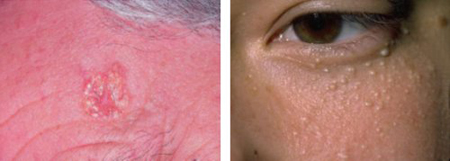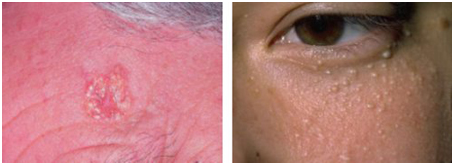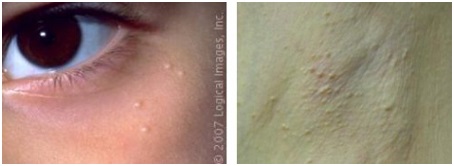
What Is a Milium Cyst?
A milium cyst is small, white bump that typically appears on the nose and cheeks. These cysts are often found in groups, and in these cases are called milia. The cysts occur when keratin becomes trapped beneath the surface of the skin. Keratin is a strong protein that is typically found in skin tissues, hair, and nail cells.
Milia can occur in people of all ages, but they’re most common in newborns. They’re typically found on the face, eyelids, and cheeks. Milia are often confused with a condition called Epstein pearls, which involves the appearance of harmless white-yellow cysts on a newborn’s gums and mouth. Milia are also often inaccurately referred to as “baby acne.”
Keep reading to learn more about milia as well as their causes and what you can do to treat them.
What Are the Types of Milia?
There are various types of milia. These cysts are classified based on the age at which they occur or the injury that causes the cysts to develop.
Neonatal Milia
Juvenile Milia
This condition is caused by genetic disorders. These include:
- nevoid basal cell carcinoma syndrome
- pachyonychia congenita
- Gardner syndrome
- Bazex-Dupré-Christol syndrome
Primary Milia in Children and Adults
Milia en Plaque
The cysts can be several centimeters in diameter. This condition is primarily seen in middle-aged women, but it can occur in adults and children of all genders and ages.
Multiple Eruptive Milia
Traumatic Milia
Milia Associated with Drugs

Milia en plaque Multiple eruptive milia

Primary Milia Secondary Milia
What Causes Milia?
The cause of milia in newborns is unknown. It’s often mistaken for baby acne, which is triggered by hormones from the mother. Unlike baby acne, milia doesn’t cause inflammation (swelling). According to the Stanford School of Medicine, infants who have milia are born with it, while baby acne doesn’t appear for a few weeks after birth.
In older children and adults, milia are typically associated with some type of damage to the skin, such as:
- blistering due to a skin condition
- burns
- blistering injuries, such as poison ivy
- skin resurfacing procedures, such as dermabrasion or laser resurfacing
- long-term use of steroid creams
- long-term sun damage
Skin biopsy is necessary if there is doubt in the diagnosis .
There is no cure for the treatment of pterygium effective primary and secondary levels. The individual reports had confirmed the success of treatment with Isotretinoin, Etretinate and Mynocyline
Surgery:
Milia is not harmful , but if the patient requires treatment , surgery can be used needle to make a small incision and remove the inside . This can be carried out without anesthesia .Milia en plaque was treated effectively with electric heating , CO2 laser and cryotherapy
Contact Us
If you have questions about the treatment of keloids at Stamford Skin Center invite you to call directly for Stamford via Hotline (08) 3925 1990 or fill out the consultation form below .